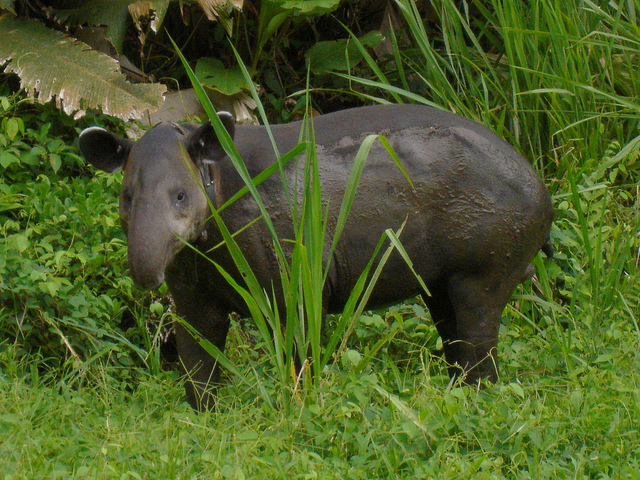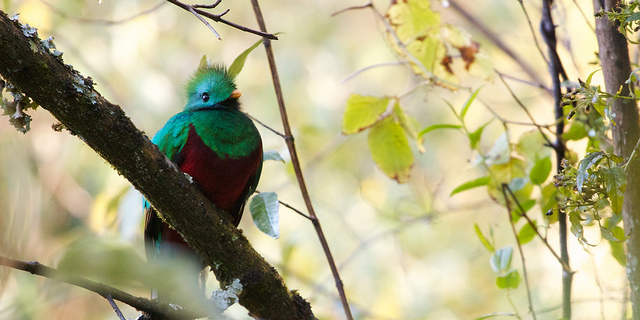Anyone who has traveled in the tropics in search of wildlife can tell you that disappointment comes easy. But Costa Rica is one place that lives up to its reputation. Costa Rica is nature’s live theater—and the actors aren’t shy. The scarlet macaws are like rainbows, the toucans and hummingbirds like the green flash of sunset. The tiny poison dart frogs are bright enough to scare away even the most dim-witted predator. And the electric-blue morphos, the neon narcissi of the butterfly world, make even the most jaded of viewers gape in awe.
Costa Rica is nature’s live theater—and the actors aren’t shy.Then there are all the creatures that mimic other things and are harder to spot: insects that look like rotting leaves, moths that look like wasps, the mottled, bark-colored machaca (lantern fly), and the giant Caligo memnon (cream owl) butterfly, whose huge open wings resemble the wide-eyed face of an owl.
A tapir in Costa Rica’s Corcovado National Park. Photo © Miguel Vieira, licensed Creative Commons Attribution.
Much of the wildlife is glimpsed only as shadows. Well-known animals that you are not likely to see are the cats—pumas, jaguars, margays, and ocelots—as well as tapirs and white-lipped peccaries. With patience, however, you can usually spot monkeys galore, as well as iguanas, quetzals, and sloths that get most of their aerobic exercise by scratching their bellies and look, as someone has said, like “long-armed tree-dwelling Muppets.”
Identifying the species is a prodigious task, which every day turns up something new. Insects, for example, make up about half of the estimated 500,000 to one million plant and animal species in Costa Rica. The country is home seasonally to more than 850 bird species—10 percent of all known bird species (the United States and Canada combined have less than half that number). There are 5,000 different species of grasshoppers, 160 known amphibians, 220 reptiles, and 10 percent of all known butterflies (Parque Nacional Corcovado alone has at least 220 different species).
Given the rich diversity of Costa Rica’s ecosystems, it may come as a surprise that only 200 mammal species—half of which are bats—live here. Several species of dolphins and seven species of whales are common in Costa Rican waters, but there are no seals. And the only endemic marine mammal species of any significance is the endangered manatee. Before people hunted them to extinction, there were many more mammal species. Even today, all large—and many small—mammal populations are subject to extreme pressure from hunting or habitat destruction.
The mostly nocturnal and near-blind nine-banded armadillo (cusuco) will be familiar to anyone from Texas. The animal can grow to almost one meter (3 feet) long. They are terrestrial dwellers that grub about on the forest floor, feeding on insects and fungi. The female lays a single egg that, remarkably, divides to produce identical triplets. Its smaller cousin, the naked-tailed armadillo, is far less frequently seen. The dog family is represented by the brown-gray coyote and nocturnal gray fox, both found mostly in the dry northwest. The marsupials—mammals whose embryonic offspring crawl from the birth canal and are reared in an external pouch—are represented by nine species of opossums. The blunt-nosed, short-spined, prehensile-tailed porcupine (puerco espín) is nocturnal and arboreal and rarely seen. There are also two species of rabbits (conejos).
Costa Rica is as renowned for its marinelife as for its terrestrial and avian fauna—most famously, perhaps, for the billfish (marlin and sailfish) that cruise the deep blue waters offshore, and for tarpon and snook, feisty estuarine and wetland game fish. The former swim seasonally in the warm waters off the Golfo de Papagayo and Golfo Dulce; the latter are concentrated in the waters of the Río Colorado and Caño Negro.
Sharks are forever present in Costa Rican waters. They seem particularly to favor waters in which marine turtles swim. Isla del Coco is renowned for its schools of hammerhead sharks, as well as giant whale sharks (the world’s largest fish), which can also be found hanging out with giant groupers, jewfish, and manta rays in the waters around the Islas Murciélagos, off the Santa Elena Peninsula in Guanacaste.
Whales—notably humpbacks—can be seen predictably along the west coast of Costa Rica December-October, when they migrate from both Antarctic and North Pacific waters to mate and give birth in the warm waters off the Costa Ballena.
With approximately 850 recorded bird species, the country boasts one-tenth of the world’s total. More than 630 are resident species; the others are travelers who fly in for the winter. Birds that have all but disappeared in other areas still find tenuous safety in protected lands in Costa Rica, although many species face extinction from deforestation.
It may surprise you to learn that in a land with so many exotic species, the national bird is the relatively drab yiquirro, or clay-colored thrush (it was previously called the clay-colored robin), a brown-and-buff bird with brick-red eyes. You may hear the male singing during the March-May breeding season when, according to campesino folklore, he is “calling the rains.”

A resplendent quetzal sits in the trees of El Silencio de Los Ángeles Cloud Forest Reserve. Photo © Matt MacGillivray, licensed Creative Commons Attribution.
The four major avifaunal zones roughly correspond to the major geographic subdivisions of the country: the northern Pacific lowlands, the southern Pacific lowlands, the Caribbean lowlands, and the interior highlands. Guanacaste’s dry habitats (northern Pacific lowlands) share relatively few species with other parts of the country. This is a superlative place, however, for waterfowl: The estuaries, swamps, and lagoons that make up the Tempisque basin support the richest freshwater avifauna in all Central America, and Parque Nacional Palo Verde, at the mouth of the Río Tempisque, is a bird-watcher’s mecca. The southern Pacific lowland region is home to many South American neotropical species, such as jacamars, antbirds, and, of course, parrots.
Depending on the season, location, and luck, you can expect to see many dozens of species on any one day. Many tour companies offer guided bird-study tours, and the country is well set up with lodges that specialize in bird-watching programs. But the deep heart of the rainforest is not the best place to look for birds: You can’t see very well amid the complex, disorganized patterns of shadow and light. For best results, find a large clearing on the fringe of the forest, or a watercourse where birds are sure to be found in abundance. The most diverse avifauna is found in the wet lowlands and forested foothills. The Organization of Tropical Studies offers half- and full-day birding workshops.
Excerpted from the Tenth Edition of Moon Costa Rica.